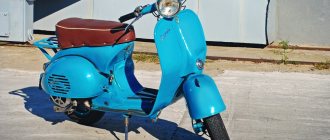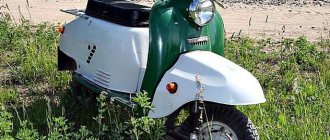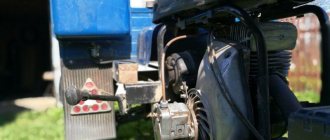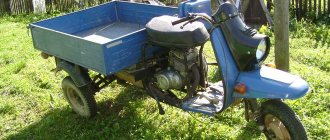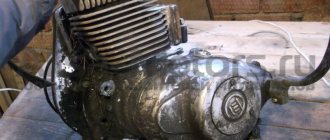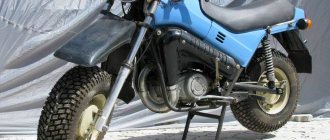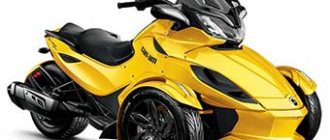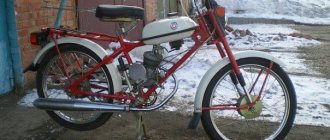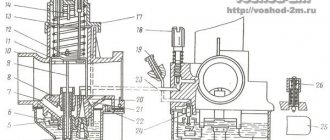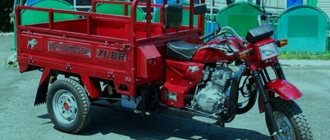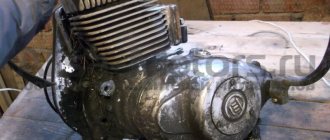The Electron scooter was developed in 1973 by the design bureau of a machine-building plant in the city of Vyatka. The task was set to create a lightweight two-wheeled vehicle for two people, economical and inexpensive. The predecessor and basis for the development was the Vyatka-150 model, which was produced since 1957 and was copied at one time from its Italian counterpart called Vespa. This prototype was used in many countries; the scooter was of the simplest design and very technologically advanced.
Power point
The engine of the Vyatka scooter is a single-cylinder, two-stroke, and has the following characteristics:
- Working volume – 148 cubic cm.
- Compression ratio – 6.7.
- Cylinder diameter – 57 mm.
- Power – 5.5 l. With.
- The piston stroke is 58 mm.
- Torque – 3800 rpm.
The ignition of the Vyatka scooter is a contact magneto with manual adjustment of the gap and spark advance. The spark plugs used were standard A16 motorcycle spark plugs. This ignition system had one significant drawback: the constant high voltage caused the contacts to burn. A depression, the so-called “cavity,” developed in one tungsten plate, and a tubercle formed on the other contact plate during engine operation, which had to be periodically cleaned off.
The carburetor of the Vyatka scooter is a diffuser with one jet of limited range. The damper was driven by a cable from the right rotating steering wheel handle. Fuel entered the carburetor by gravity from the gas tank located under the seat. The tap, located at the bottom of the tank, was connected to the carburetor with a flexible hose made of gasoline-resistant rubber. The diameter of the hose clearance is sufficient for the unhindered supply of fuel. The fuel supply could be shut off by turning the tap handle. The carburetor was equipped with a special rod on the float chamber cover, designed to submerge the float before starting the engine in cold weather. When the rod was pressed, a free flow of gasoline opened, the mixture became richer, and the engine started.
The design of the chassis is a welded frame combined with a supporting stamped body. The body of a convenient layout allowed the driver to sit behind the wheel with sufficient comfort. The Vyatka scooter was ideal for those who didn’t want to drive fast. The two-seater seat easily accommodated both driver and passenger. Behind the seat there was a small luggage rack on which you could place a bag with things or some small cargo. Below the trunk, a brake light was mounted, and even lower, a bracket with a license plate. And this whole “ensemble” was completed by a rubber mudguard with the embossed inscription “VPMZ,” the abbreviation of the manufacturing plant.
Scooter owners noted such a significant drawback as overheating of the motor. The engine's location did not allow air to circulate to the extent needed for efficient cooling. In addition, the engine niche was tightly closed with casings on both sides. On the left side there is a stationary round-shaped trunk, and on the right side there is a removable casing that covers all the engine mechanisms. Longitudinal grooves were cut into this cap, designed to provide access to air masses, but they were not enough. Many scooter drivers removed the right cover to open up access to oncoming air flow, but such actions were stopped by the traffic police.
Three-wheeled modifications
In the fall of 1959, at the exhibition “Motor scooters and motorcycles”, held at the Moscow Polytechnic Museum, various three-wheeled versions of the “Vyatka” were presented. The engine on all models was located in the middle, rotation was transmitted to the rear wheels through a bevel differential, and then to the rear drive wheels.
The Vyatka scooter in this version was widely used in the field of grocery delivery around the city. A total of three variants were produced: the MG-150F model, with a closed body, the MG-150 with an open platform, and the MG-150S with a dump body. All modifications had a carrying capacity of 250 kilograms. The speed of movement did not exceed 35 km/h.
A little history
Licensed, modernized and even pirated versions produced all over the world have made the Italian scooter very popular. Vyatka manufacturers also could not resist the temptation to use Vespa as the base model for the first Soviet scooter. They did not make a complete copy for fear of claims from Italy, but used the basic parameters.
So in 1957 the “Vyatka-150” appeared, and in 1964 the modification “Vyatka-150VP” was created, which differed from the previous version in an extended base, a new body, and a modernized front fork. The rear suspension received a chain drive instead of the previous direct connection of the engine to the drive wheel.
"Vyatka" as a service transport
At the request of VDNKh, the plant developed the VP-150T motorcycle taxi model, where the two driving wheels were located in front and were steerable. In addition to the driver in the back, there were two people in the front seat. The miniature vehicle aroused keen interest among the public and was in demand among visitors to the National Economy Exhibition.
To ride a motorcycle taxi from one pavilion to another, many were even willing to wait in a short line. The fare was symbolic. The motorcycle taxi was especially pleasing to the children, who asked their parents to ride again and again. Yes, actually, mom and dad weren’t averse to taking a ride on such an unusual vehicle either.
The motorcycle taxi was produced in the amount of 50 copies.
"Vyatka-Electron"
In 1965, a new model was developed based on the Vyatka 150. The scooter was named “Vyatka-Electron”. It differed from its predecessor in a new body with less rounded contours, an elongated base, a front long-link fork and more compact shock absorbers. At the same time, the Vyatka-Electron scooter retained the engine in its original form, but boosted to a power of 6 hp. With. Due to the extended base, it was necessary to make an intermediate chain drive, which became part of the rear wishbone suspension. The chain drive was hermetically sealed to prevent dust or dirt from getting into it in rainy weather.
Serial production of the new model began in 1967, and the outdated Vyatka 150 scooter was discontinued in the same year. The new model immediately gained popularity among young people. Being the owner of a beautiful sparkling car was considered prestigious. The economical motor of the scooter worked silently, and full filling of the gas tank cost no more than one ruble.
In 1973, the Vyatka-Electron scooter was modernized, the engine power increased and amounted to 7 hp. s., while fuel consumption remained the same - 3.1 liters per 100 kilometers. The design of the case has changed. But the main and most spectacular result of the scooter’s restyling was the installation of electronic contactless ignition. In the USSR, this was the first time the promising device was used. However, every new product has its positive and negative sides. If the electronics failed, the owner of the scooter could not figure out the problem on his own and was forced to look for special services or a private specialist to troubleshoot the problem. Thus, the supposed advantage often turned into criticism. But in general, the Vyatka-Electron scooter was a popular means of transportation.
ELECTRICAL EQUIPMENT OF MOTOR SCOOTER VYATKA - June 1958
- Online Archive
- Forum
- Wiki
- Buy a car
- Magazine “Behind the wheel”
- Online store
To come in
- Announcements
- Editions Behind the Wheel
- Newspaper "Behind the wheel - Region"
- Buy a car
- Moto
- Flight
- New items
- All brands
Search
- Announcements
- Behind the wheel
- Newspaper "Behind the wheel - Region"
- Buy a car
- Moto
- Flight
- Books and catalogs
- Makes and models
- Search
- ZR 2018
- ZR 2017
- ZR 2016
- ZR 2015
- ZR 2014
- ZR 2013
- ZR 2012
- ZR 2011
- ZR 2010
- ZR 2009
- ZR 2008
- ZR 2007
- ZR 2006
- ZR 2005
- ZR 2004
- ZR 2003
- ZR 2002
- ZR 2001
- ZR 2000
- ZR 1999
- ZR 1998
- ZR 1997
- ZR 1996
- ZR 1995
- ZR 1994
- ZR 1993
- ZR 1992
- ZR 1991
- ZR 1990
- ZR 1989
- ZR 1988
- ZR 1987
- ZR 1986
- ZR 1985
- ZR 1984
- ZR 1983
- ZR 1982
- ZR 1981
- ZR 1980
- ZR 1979
- ZR 1978
- ZR 1977
- ZR 1976
- ZR 1975
- ZR 1974
- ZR 1973
- ZR 1972
- ZR 1971
- ZR 1970
- ZR 1969
- ZR 1968
- ZR 1967
- ZR 1966
- ZR 1965
- ZR 1964
- ZR 1963
- ZR 1962
- ZR 1961
- ZR 1960
- ZR 1959
- ZR 1958
- ZR 1957
- ZR 1956
- ZR 1955
- ZR 1954
- ZR 1953
- ZR 1952
- ZR 1951
- ZR 1950
- ZR 1949
- ZR 1948
- ZR 1947
- ZR 1946
- ZR 1945
- ZR 1944
- ZR 1943
- ZR 1942
- ZR 1941
- ZR 1940
- ZR 1939
- ZR 1938
- ZR 1937
- ZR 1936
- ZR 1935
- ZR 1934
- ZR 1933
- ZR 1932
- ZR 1931
- ZR 1930
- ZR 1929
- ZR 1928
- №1
- №2
- №3
- №4
- №5
- №6
- №7
- №8
- №9
- №10
- №11
- №12
- To review the issue
- 0 — CAR RALLIES
- 0 - Power unit for microcars
- 0 - DO IT YOURSELF
- 0 — ISSUE COVER
- 0 — TRAINING TECHNICAL PERSONNEL IN RURAL RESIDENCES IS THE MOST IMPORTANT TASK OF DOSAAF
- 2 - TOGETHER WITH KOMSOMOLE MEMBERS
- 3 — TRAINING OF DRIVING PERSONNEL IN RURAL STAFF IS EXPANDING
- 3 — CHRONICLE OF USEFUL ACTIVITIES
- 4 — LABINSKY INTERDISTRICT
- 6 - ON THE BORE OF THE ANGARA
- 7 - A START IS MADE
- 7 — OUR INTERVIEWS
- 8 – WHERE TO PUT THE CAR
- 9 — WHAT CONCERNS OUR READERS
- 9 — ABOUT NEW GRADES OF FUEL AND LUBRICANTS
- 10 — RECTIFIER FOR CHARGING CAR AND MOTORCYCLE BATTERIES
- 11 – CAR RALLIES
- 13 - DO IT YOURSELF
- 14 — MINIC CARS
- 16 - AMERICAN CARS 1958
- 17 — ELECTRICAL EQUIPMENT OF THE VYATKA MOTOR SCOOTER
Declining popularity
Despite its innovative characteristics, the Vyatka-Electron scooter gradually began to lose demand. And by the end of the 70s, its sales dropped to almost zero. Overstocking began in warehouses, and stores massively refused new supplies. The drop in demand is explained by the fact that the population has the opportunity to purchase cars on a larger scale. Many people preferred to buy domestic motorcycles; moreover, at the end of the 60s, deliveries of the Czechoslovak “Java” began to the USSR, which created a real sensation among young people.
As a result of all these changes, the Vyatsko-Polyansky plant stopped production of the Vyatka-Electron scooter in August 1979. The history of such a vehicle ends here. And in the early 90s, after the collapse of the Soviet Union, the plant launched the production of the small “Strizh” scooter, copied from the German “Simson”.
Repair support for motor scooters
More than thirty-five years have passed since production. Almost all scooters of both modifications - both "Vyatka" and "Vyatka-Electron" - have long since been scrapped. However, a certain number of cars are still in the hands of antique connoisseurs and collectors. Rare specimens need repairs, which means they need spare parts. The Vyatka-Electron scooter has been preserved better than its predecessor, but it also needs restoration. Spare parts can still be found at used equipment junkyards or even in stores that sell repair kits for motorcycles and scooters.
The dream of my youth began to come true! And I, like a fifteen-year-old boy, in puppy delight, rushed to implement it. Motorcycle is my dream! As people later said, my “dream come true” is somehow wrong: “I would buy a normal moto and not worry about it,” said one of my colleagues... Why bother with scrap metal? This phrase came out after I showed him a photo of a “Vyatka” scooter on one of the message boards on the Internet. After calling the owner of the scooter, I already knew that it was stainless, started, drove, and did not have the normal documents for it, because it had never been registered with the traffic police. I was already completely satisfied with this. It was necessary to go for “Vyatka” to the city of Pavlovo, Nizhny Novgorod province. We agreed on a price and a meeting next Friday. When the driver of the Chinese semi-truck in our office found out where and why we were going, he immediately agreed to spend the weekend on a business trip. Then he asked five more times if I had changed my mind about going. But I haven’t changed my mind and I never would! Four hundred kilometers - and we are there. The owner of the scooter, a man about 55-60 years old, came out and went into the garage. No wonder I went! That's for sure! In the garage there was a motor scooter painted with a broom to match the color of the fence. A huge thank you to whoever made this blue paint. She saved iron from the ubiquitous rust. A quick inspection showed: - complete set - complete original; — mileage – a little over 14 thousand; — not rusty or wrinkled, not counting the little things; - even the tires are original. I paid it off, wrote something like a purchase and sale agreement on my knee, so that I could brush off the traffic police officers. - Start it up! – I said and stepped aside just in case. The cold engine, surprisingly, started at half a click and rattled cheerfully. Five minutes of warming up and off you go. Sitting on such a device is not just fun – it’s a SUPER MEGA SENSATION!!! The gears are switched on like a moped: I squeeze the clutch, push the lever up, unscrew the gas, and the old guy takes off up the hill with unexpected agility. I am in shock and barely have time to slow down at the tailgate of my truck. Neutral, the smooth whirring of the engine and the driver's laugh. - Well, how? Like? – asked the approaching, now former, owner of the scooter. There are no words – I’m as happy as a little child! In addition, I was given an operation, maintenance and repair manual, as well as a certificate from the store where they bought the Vyatka in 1964. Everything is original and slightly yellowed. Pirate treasures are complete nonsense compared to these pieces of paper! We loaded it, tied it down carefully and went home. The traffic police ignored us, the weather was bad, so by evening we were at the base. Sunday. To the store for kebabs and to the factory soon! Ride a scooter! My girls were just as happy as I was. And how we ride, you can see Photos of different types of scooters:
Hello everybody! Please accept me into the Brotherhood of Motorcyclists. I solemnly promise: to obey traffic rules, to help all two-wheeled people and everyone who needs my help everywhere and always!
